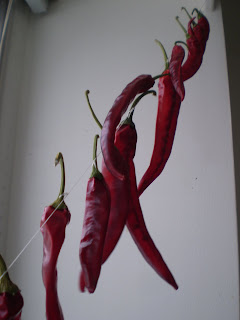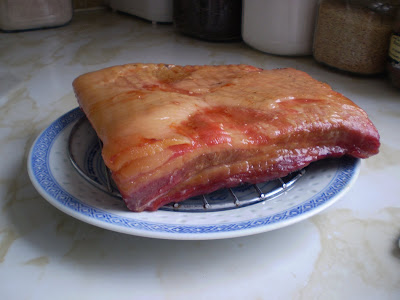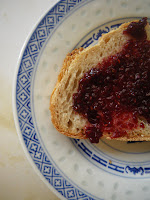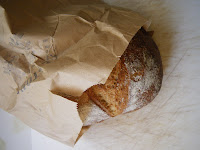Over the past year, my interest in broths and stocks has increased with each passing week. My first encounter was at Hulbert’s, where Chris would save vegetable trimmings--carrot skins, thick, white celery ends, and onion roots--in a pot in the cooler. Never broccoli or cauliflower, he said, because they produce a “skanky” broth. Once enough scraps had accumulated they were thrown in a stock pot, covered with water, simmered for eight hours, and strained. At the time this was just a curious process that I figured I would try at home, eventually.
Then I read Alton Brown’s I’m Just Here for the Food, which details the process of making stock from chicken carcasses. The “sauces” section of that book convinced me of the usefulness of having a ready reserve of stock in the freezer. I now thought of stock as a useful trick up my culinary sleeve.
During the summer, when Lisa and I were making most of our meals from scratch, we were often wishing we had stock so we could make soups, sauces, and gravies. Going through lots of produce and a few whole chickens, we gathered enough scraps to produce the occasional batch of the elusive liquid.
Furthermore, we recently bought stainless steel cookware, and the sticky bits left in the pan after we cook meat are absolutely begging to be deglazed with stock and made into an accompanying sauce.
The final blow came while reading Anthony Bourdain’s book Kitchen Confidential, where I found lines like, “Stock is the backbone of good cooking,” and “Life without stock is barely worth living.” Needless to say, these words added an almost desperate urgency to my experiments with stock.
I started some research. Very few professional sources recommended the use of cutting board scraps. I guess this makes sense, as consistency is usually an obsession of the restaurant industry, and the hodge-podge stock pot produces a different product every time. It’s still a great method for the home kitchen, though.
Using fresh, whole vegetables for a mere stock seemed criminal at first, but by the last harvest day at our CSA, Lisa and I were completely overwhelmed. Even after freezing and canning what we could, there was a surplus of the very vegetables that most vegetable stock recipes call for.
I eventually decided to try a Robuchon recipe that uses vegetables, herbs, dry white wine and star anise. I’ve appended the recipe below. I also gleaned the following advice from Joel: simmer very, very gently, otherwise the finished stock will be cloudy.
I set to work. When the mixture first started to simmer, all I could smell was anise, and I was worried that its unique taste would completely obscure the subtler aromatics. By the time the stock was done, the anise had married well with the others. The wine added a mild, pleasant acidity.
I'm hooked. My next experiment will be beef stock. Apparently the first step in that process is procuring beef bones. I need to befriend a butcher. Fast.
Vegetable Stock (From The Complete Robuchon)
3 stalks celery, roughly chopped
2 leeks, roughly chopped
2 carrots, roughly chopped
1 onion, roughly chopped
2 cloves garlic, chopped
2 cups dry white wine
2 whole star anise
1 bouquet garni (3 stems parsley, thyme, and 1/2 bay leaf)
2 scant teaspoon coarse salt
pepper
6 1/4 cups water
Combine ingredients and simmer very gently for three hours, skimming foam from surface every half hour. Yields about one litre of stock.

























